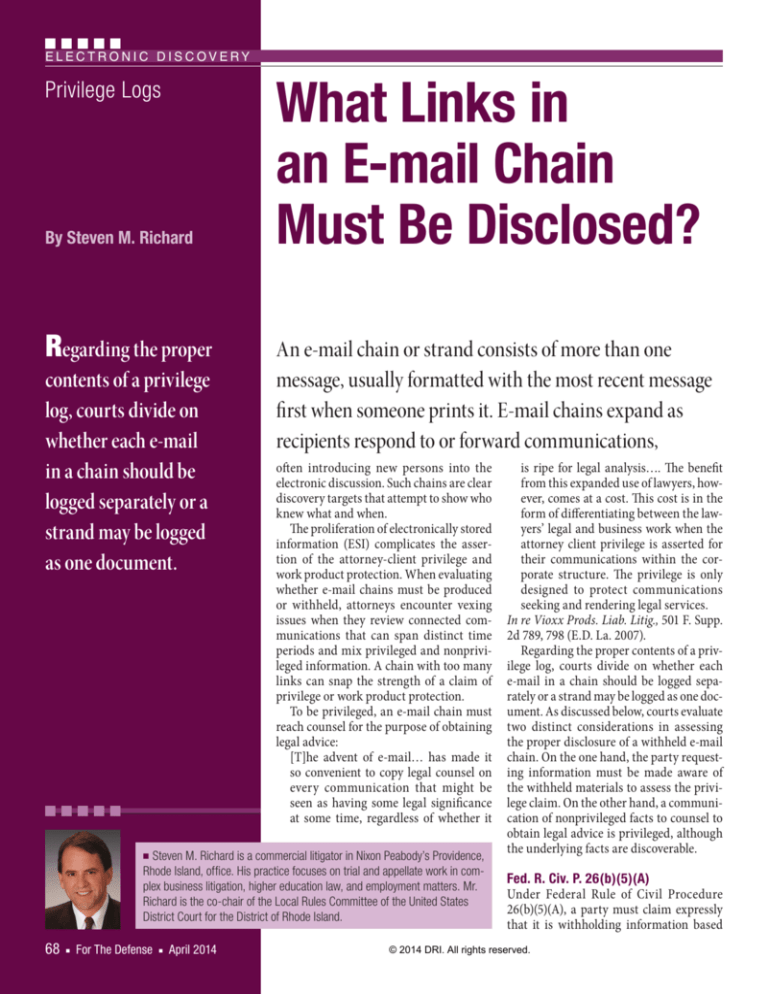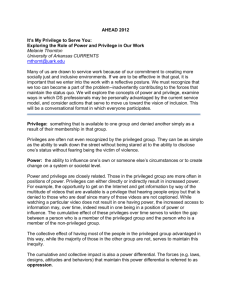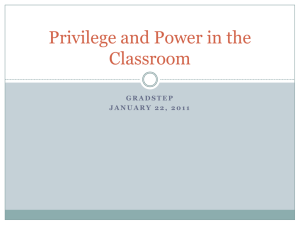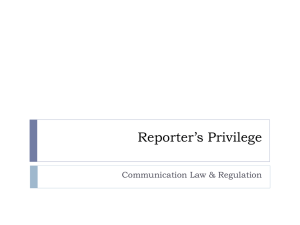
ELECTRONIC DISCOVERY
Privilege Logs
By Steven M. Richard
Regarding the proper
contents of a privilege
log, courts divide on
whether each e-mail
in a chain should be
logged separately or a
strand may be logged
as one document.
What Links in
an E-mail Chain
Must Be Disclosed?
An e-mail chain or strand consists of more than one
message, usually formatted with the most recent message
first when someone prints it. E-mail chains expand as
recipients respond to or forward communications,
often introducing new persons into the
electronic discussion. Such chains are clear
discovery targets that attempt to show who
knew what and when.
The proliferation of electronically stored
information (ESI) complicates the assertion of the attorney-­client privilege and
work product protection. When evaluating
whether e-mail chains must be produced
or withheld, attorneys encounter vexing
issues when they review connected communications that can span distinct time
periods and mix privileged and nonprivileged information. A chain with too many
links can snap the strength of a claim of
privilege or work product protection.
To be privileged, an e-mail chain must
reach counsel for the purpose of obtaining
legal advice:
[T]he advent of e-mail… has made it
so convenient to copy legal counsel on
every communication that might be
seen as having some legal significance
at some time, regardless of whether it
Steven M. Richard is a commercial litigator in Nixon Peabody’s Providence,
Rhode Island, office. His practice focuses on trial and appellate work in complex business litigation, higher education law, and employment matters. Mr.
Richard is the co-chair of the Local Rules Committee of the United States
District Court for the District of Rhode Island.
■ 68 For The Defense April 2014
■
■
is ripe for legal analysis…. The benefit
from this expanded use of lawyers, however, comes at a cost. This cost is in the
form of differentiating between the lawyers’ legal and business work when the
attorney client privilege is asserted for
their communications within the corporate structure. The privilege is only
designed to protect communications
seeking and rendering legal services.
In re Vioxx Prods. Liab. Litig., 501 F. Supp.
2d 789, 798 (E.D. La. 2007).
Regarding the proper contents of a privilege log, courts divide on whether each
e-mail in a chain should be logged separately or a strand may be logged as one document. As discussed below, courts evaluate
two distinct considerations in assessing
the proper disclosure of a withheld e-mail
chain. On the one hand, the party requesting information must be made aware of
the withheld materials to assess the privilege claim. On the other hand, a communication of nonprivileged facts to counsel to
obtain legal advice is privileged, although
the underlying facts are discoverable.
Fed. R. Civ. P. 26(b)(5)(A)
Under Federal Rule of Civil Procedure
26(b)(5)(A), a party must claim expressly
that it is withholding information based
© 2014 DRI. All rights reserved.
upon privilege or attorney work product.
The party must describe the nature of the
withheld documents to enable the other
parties to assess the claim. Although not
expressly required by Federal Rule 26(b)(5)
(A), courts have customarily required and
parties have produced privilege logs to disclose what has been withheld.
The Advisory Committee on Rules of
Civil Procedure notes to Federal Rule 26(b)
(5), enacted in the 1993 amendments to the
Federal Rules, state that a proper disclosure
of withheld information will “reduce the
need for in camera examination of the documents.” A party that withholds materials
without properly describing their nature
and extent faces the prospect of sanctions
under Federal Rule 37(b)(2) and risks a
waiver of the privilege or protection. See,
e.g., C.T. v. Liberal School Dist., 2007 U.S.
Dist. Lexis 38177, at *17–18 (D. Kan. May
24, 2007) (“If any of the emails listed in the
amended privilege log constitute a ‘string’
or ‘stand’ email, the amended privilege log
‘will also list each e-mail within the strand
as a separate entry. Otherwise, the client
may suffer a waiver of the attorney-­client
privilege or work product protection (and
the lawyer may later draw a claim from the
client).’”). A party may seek relief under
Federal Rule 26(c) through a protective
order if complying with Federal Rule 26(b)
(5)(A) imposes an unreasonable burden.
The Advisory Committee on Rules of
Civil Procedure notes state that
[t]he rule does not attempt to define for
each case what information must be
provided when a party asserts a claim
of privilege or work product protection.
Details concerning time, persons, general subject matter, etc., may be appropriate if only a few items are withheld,
but may be unduly burdensome when
voluminous documents are claimed to
be privileged or protected, particularly if
the items can be described by categories.
As a result, litigants must assess and balance practical and case specific considerations regarding the proper disclosure of
withheld e-mail chains.
“Stealth” Claims of Privilege
In re Universal Service Fund Telephone
Billing Practices Litigation, 232 F.R.D. 669
(D. Kan. 2005), held that each e-mail in
a strand must be listed separately. The
defendant logged 131 e-mails contained
within 35 strands into five separate categories. Id. at 671. It argued that an e-mail
strand is similar to a “conversation,” “minutes of a meeting,” or a “transcript.” Id. at
673. The court rejected the comparison for
three reasons. First, e-mail strands may
span several days, which makes them distinct from a meeting or conversation. Second, the individuals receiving or being
copied within a strand may vary, and they
may include persons who may receive only
parts of the communications or may be
outside of the attorney-­client relationship.
Third, one e-mail may contain a privileged communication and another within
the same stand may communicate factual,
nonprivileged information. Id.
The court warned that the “unavoidable byproduct” of the defendant’s position
would be “stealth claims of privilege which
by their very nature, could never be subject to a meaningful challenge by opposing
counsel or actual scrutiny by a judge; this,
in turn, would render Fed. R. Civ. P. 26(b)
(5) a nullity.” Id. The court was “acutely
sensitive to the fact” that requiring each
e-mail in a strand to be listed separately
may be a “laborious, time-­intensive task
for counsel” that adds to litigations costs.
Id. at 674. Yet, the court determined that
adherence to this procedure is essential to
test the appropriateness of an assertion of
attorney-­client privilege or work product
protection. Id.
Other courts have adopted reasoning
similar to the In re Universal Service Fund
Telephone Billing Practices Litigation reasoning and required a withholding party
to identify each communication separately.
See, e.g., BreathableBaby, LLC v. Crown
Crafts, Inc., 2013 U.S. Dist. Lexis 95508, at
* 25–29 (D. Minn. May 31, 2013) (individual entries for each e-mail in a chain ensure
that parties “do not bury non-­privileged
communications in e-mail chains that were
forwarded to counsel for legal advice”);
Helm v. Alderwoods Group, Inc., 2010 U.S.
Dist. Lexis 86353, at *9 (N.D. Cal. July 27,
2010) (noting that the application of privilege principles to e-mail communications
is “a matter of disagreement among district
courts” and adopting the separate communication requirement); Chemtech Royalty
Assoc., L.P., 2009 U.S. Dist. Lexis 27696,
at *13–14 (M.D. La. 2009) (explaining that
“the sufficiency of privilege log descriptions
are decided on a case-by-case basis,” but
disfavoring “email strings without explanation as to each part….”); Baxter Healthcare Corp. v. Fresenius Med. Care Holding,
Inc., 2008 U.S. Dist. Lexis 85180, at *4 (N.D.
Ca. Oct. 10, 2008) (each e-mail is a separate communication that stands on its own
for purposes of a claimed privilege); In re
Although not expressly
required by Federal Rule
26(b)(5)(A), courts have
customarily required and
parties have produced
privilege logs to disclose
what has been withheld.
Vioxx Prods. Liab. Litig., 501 F. Supp. 2d at
812 (“Simply because technology has made
it possible to physically link these separate
communications (which in the past have
been separate memoranda) does not justify
treating them as one communication and
denying the demanding party a fair opportunity to evaluate privilege claims raised by
the producing party.”).
A Contrary View
An example of how views can diverge
regarding the proper logging of e-mail
chains on a privilege log involves two rulings issued by the United States District
Court for the Northern District of Illinois
in Muro v. Target Corp., 243 F.R.D. 301,
306–07 (N.D. Ill. 2007), reversed in relevant part, 250 F.R.D. 350, 362-63 (N.D. Ill.
2007). Initially, a magistrate judge relied
upon In re Universal Service Fund Telephone Billing Practices Litigation to rule
that the defendant’s failure to log e-mails
individually violated Federal Rule 26(b)(5)
(A). 243 F.R.D. at 305–07. The magistrate
judge wrote, “Listing only the most recent
e-mail, as [defendant] did, fails to disclose
important information about what is being
withheld from production.” Id. at 307. The
For The Defense April 2014 69
■
■
ELECTRONIC DISCOVERY
ruling focused upon the need to confirm
that the distribution of the chains, which
were widely disseminated, did not compromise or waive confidentiality, especially if
communications reached individuals that
the attorney-­client relationship did not
encompass. Id. at 308.
The district court judge reversed the discovery ruling, notwithstanding the “exis-
Counsel and a client
should coordinate a
clear understanding of
the proper recipients
copied on all e-mails and
responses containing
privileged information.
tence of persuasive authority supporting
[the magistrate’s position].” 250 F.R.D.
at 363. The judge was particularly concerned that requiring the identification of
each e-mail could disclose privileged communications. Id. Although one e-mail is
not privileged, a second email that forwards the previous e-mail to counsel might
be privileged in its entirety. Id. “In this
respect, the forwarded material is similar
to prior conversations or documents that
are quoted verbatim in a letter to the party’s
attorney.” Id. The judge relied upon Upjohn
Co. v. United States, 449 U.S. 383 (1981), to
protect the confidentiality of a communication with counsel that includes unprotected
underlying information. Id. Consequently,
the judge concluded that a party may properly withhold an entire e-mail containing
and forwarding particular previous materials to legal counsel as long as the party
discloses those materials themselves. Id.
Muro allows an e-mail chain forwarded
to counsel to obtain legal advice to be
logged as a single document provided that
the “individual versions” of the forwarded
e-mails are produced or separately logged
if they are privileged themselves. Id. Otherwise, the court reasoned that the disclosure
70 For The Defense April 2014
■
■
of the information conveyed to legal counsel could breach the attorney-­client privilege by allowing opposing counsel to see
or to ascertain what information has been
provided to the withholding party’s counsel. Id. The judge explained, “Rule 26(b)(5)
(A) requires only that a party provide sufficient information for an opposing party
to evaluate the applicability of privilege,
‘without revealing information itself privileged.’ Thus, [the magistrate judge] erred
by reading this rule to require a method of
itemization that will, in some cases, force
to disclose privileged information.” Id. See
also Continental Casualty Co. v. St. Paul
Surplus Lines Ins. Co., 265 F.R.D. 510, 517
n. 9 (E.D. Ca. 2010); Barton v. Zimmer, 2008
U.S. Dist. Lexis 1296, at *16 (N.D. Ind. Jan.
8, 2008); United States v. Chevron Texaco
Corp., 241 F. Supp. 2d 1065, 1074 n.2 (N.D.
Cal. 2002).
Rhoads’ Map
Rhoads Indus. Inc. v. Building Materials Comp. of Am., 254 F.R.D. 238 (E.D.
Pa 2008), addressed an order entered in
the case requiring the production of certain e-mails not properly identified on
the plaintiff’s privilege log, and the plaintiff requested clarification regarding its
production obligations regarding e-mail
chains. In response, the court expressed
hesitancy to adopt “a broad, black-letter rule,” especially because the privilege
issues associated with e-mail chains had
been “frequently discussed in continuing
legal education seminars and among lawyers attempting to deal with electronic discovery issues.” Id. at 241.
The Rhoads court relied and expanded
upon the ruling in Muro:
A situation may arise when a number of
email messages, by themselves not privileged, but eventually sent to an attorney
for the purpose of securing legal advice,
become privileged. If they are not produced, they must be logged individually in order to claim the privilege, but
they do not have to be detailed in the log
entry describing the email message sent
to the attorney.
On the other hand, if the email messages are part of routine business affairs,
and not for the purpose of securing
legal advice, then the underlying emails
would be discoverable. If a party asserts
that, because they are eventually sent to
the attorney, the messages become privileged then each must be entered on the
privilege log.
As an over-­arching matter, it is
important to recognize in this entire discussion the distinction between “facts”
and “communications” because a party
with an obligation to provide discovery
must always be sure it has disclosed the
facts, since it is only the communications with counsel that are privileged.
Id. at 241.
Rhoads held that “each version of an
email string (i.e., a forward or reply of a
previous e-mail message) must be considered a separate, unique document.” To
illustrate this point, the court noted that an
e-mail string consisting of four messages
contains four distinct versions that must be
separately analyzed. Id. at 241, n. 4. Additionally, there could be other e-mail strings
consisting of some or all of the four e-mail
messages, which would likewise have to
be separately analyzed. Id. Rhoads also
noted how unique versions can grow as a
chain expands: “One important characteristic of email, apparently not addressed in
prior opinions, is that a prior message can
be manipulated. For example the person
receiving an email message can, in replying or forwarding to any person, delete the
identity of other senders or include part of
the message.” Id. at 239 n.1.
A Categorical Approach
As noted in Rhoads, commentators
have offered diverse opinions and positions on the issues of asserting privilege
with respect to e-mail chains. The Honorable John M. Facciola and Jonathan M.
Redgrave contend that a document-­by-­
document privilege log is impractical with
ESI. Asserting and Challenging Privilege
Claims in Modern Litigation: the Facciola-­
Redgrave Framework: 4 Fed. Cts. L. Rev.
19 (2010). They propose a “new approach
that is premised on counsel’s co-­operation
supervised by early, careful, and rigorous judicial involvement.” Id. The authors
advocate that counsel should agree on categories of “clearly privileged” and “clearly
not privileged” ESI to reduce the number of
documents that must be included on a privilege log and potentially subject to in camera review. Id. at 39–40. Judge Facciola and
Mr. Redgrave recommend that the parties
use the “last-in-time” e-mail in each string,
provided that (1) each separate communication in the chain is at some point the
“last in time” e-mail in a string, and (2) the
index or privilege log states that the e-mail
is part of a string. Id. at 49. If an embedded
e-mail is not otherwise available, it should
be identified and indexed separately, as well
as categorized. Id.
Check the Local Rules, Guidelines,
and Standing Orders
As part of efficient case management, district courts prescribe protocols for electronic discovery in their local rules,
guidelines, and standing orders, which
include provisions for the identification
of withheld e-mail chains on the basis of
privilege. For example, the United States
District Court for the District of Maryland has issued “Discovery Guidelines”
that encourage the parties to confer and to
reach agreement regarding how to assert
privilege or protection claims with respect
to e-mail chains, and if they are unable to
do so, to bring their disagreement to the
judge’s attention for prompt resolution. D.
Md. Discovery Guideline 10(d)(v). See also
D. Kan. Guidelines for Cases Involving ESI
at 6–7 (“Counsel should attempt to agree
on the scope of e-mail discovery and e-mail
search protocol. The scope of e-mail discovery may require determining whether the
unit for production should focus on the
immediately relevant e-mail or the entire
e-mail string that contains the relevant
e-mail. In addition, counsel should focus
on the privilege log ramifications of selecting a particular unit of production.”) (citing In re Universal Serv. Fund Tel. Billing
Practices Litig.).
Recognizing the time and expense associated with ESI in large cases, the United
States District Court for the Southern
District of New York has issued a Standing Order, M10-468, designating cases
for inclusion in the court’s Pilot Program
Regarding Case Management Techniques
for Complex Litigation. The following
requirements are imposed on privilege log
descriptions of e-mail threads:
For purposes of creation of a privilege
log, a party need include only one entry
on the log to identify withheld emails
that constitute an uninterrupted dia-
logue between or among individuals;
provided, however, that disclosure must
be made that the e-mails are part of an
uninterrupted dialogue. Moreover, the
beginning and ending dates and times
(as noted on the emails) of the dialogue
and the number of emails within the
dialogue must be disclosed, in addition
to other requisite privilege log disclosure, including the names of the recipients of the communications.
S.D.N.Y. Standing Order, M10-468, II(E)
at 6.
Practical Suggestions
Counsel and a client should take proactive measures to limit the proliferation of
e-mail chains. The purpose of a privileged
or protected communication should be
clearly expressed, indicating that it is written to seek or to provide legal advice. Counsel and a client should coordinate a clear
understanding of the proper recipients copied on all e-mails and responses containing privileged information. Explicit “do not
forward” restrictions should be understood
by all of the approved recipients. Companies should also alert employees to limit
intermixing nonprivileged business with
privileged legal issues in e-mail chains.
Once litigation is anticipated or initiated, counsel should be guided by the
goals of practicality and proportionality to
mitigate the possibility that the time and
expense of ESI discovery may overwhelm a
case. Federal Rule of Civil Procedure 26(f)
(3)(C)-(D) requires the parties to confer and
to develop a proposed discovery plan to be
submitted to the district court. In doing
so, the parties should not lose sight of the
overriding goal of Federal Rule 1 to secure
the just, speedy, and inexpensive determination of every action and proceeding. As
part of the required Federal Rule 26(f) discovery planning, the parties must address
issues relating to the disclosure and the
production of ESI and issues relating to
claims of privilege or work product protection. Similarly, Federal Rules 16(b)(3)
(B)(iii)-(iv) require these items to be discussed with a court as part of its issuance of
the scheduling order. Counsel should come
to a mutual understanding regarding their
identification of e-mail strands in privilege
logs consistent with controlling authority
in the jurisdiction in ways that further the
efficient management of discovery. Practical and creative approaches could include
(1) categorical logs based upon the parties’ discussion of the claims and defenses,
and (2) agreements regarding applicable
date ranges controlling the disclosures that
must be made on a privilege log.
The risk of inadvertent production of
privileged communications can be minimized if the counsel discuss clawback
agreements, as allowed under Federal Rule
of Evidence 502. Under Federal Rule of Evidence 502(d), a federal district court may
enter a “nonwaiver” order, even without
agreement of the parties, which precludes
a waiver claim and avoids the need to litigate the reasonableness of inadvertent production. By reducing the risk of waiver, the
order removes one reason that parties conduct exhaustive and expensive preproduction review. Fed. Judicial Ctr., Benchbook
for U.S. District Court Judges §6.01(D)(3),
at 195–96 (Sixth ed. March 2013).
For The Defense April 2014 71
■
■






